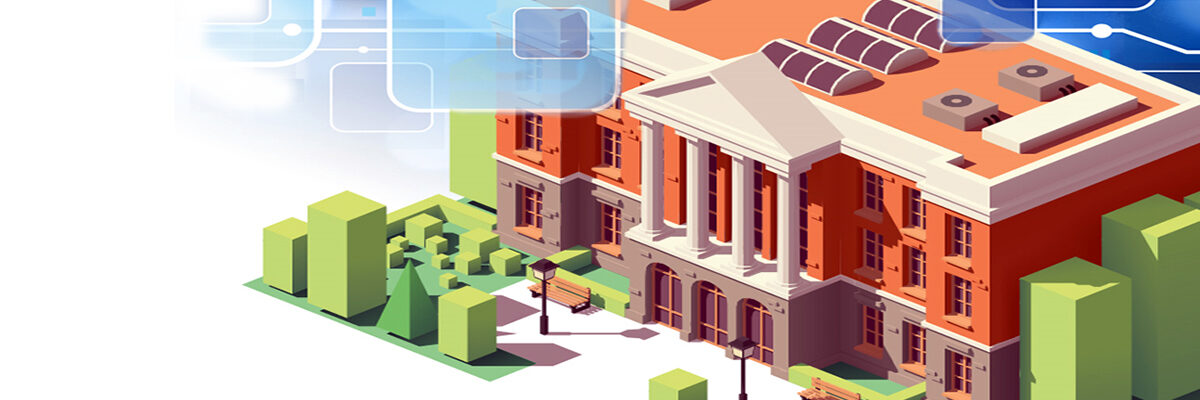— by Joseph Bocchiaro III, Ph.D., CStd, CTS-D, CTS-I, ISF-C
To prepare for the “near future” in academia, building technology experts recommend the following upgrades to campus assets.
Health and Physical Safety
The foremost topic in post-COVID discussions is protecting the health and safety of everyone on the campus. Beyond traditional electronic building security, this category now includes both well-being and inclusion. Physical security systems are being stretched to include some new ideas, while older ideas are being rethought. Facial and voice recognition is being considered not only to identify transgressors, but to identify occupants and to ascertain their health status. Physical distancing policies may be monitored with this technology by using actual occupancy numbers.
This rapidly emerging technology must become more sensitive to potential biases in artificial intelligence algorithms that may be racially skewed. We also must be cognizant of the potential biases in tools such as Crime Prevention Through Environmental Design (CPTED), such that no one feels threatened by the presence of the technology. In all cases, the placement of security cameras must be reconsidered to allow for artificial intelligence recognition and to avoid intimidation.
Electronic Communications
One of the biggest early initiatives in the COVID era has been the introduction of signage related to occupant behavior policies such as physical distancing and mask wearing. These signs, particularly the digital ones (e.g., direct-view video displays) will continue to be useful in the new era. Facilities professionals should consider developing and deploying campus-standard digital signage to accommodate rapid changes across campus with a consistent template. Many options are now available for managing content on such signage networks, and they have become highly scalable, easy to use, and updatable.
Another emerging idea is the creation of customized smartphone apps for buildings. These allow more immediate communication with occupants who may also be located off-campus. Many communications possibilities are being rolled out, related to important topics such as building air quality, health and safety guidelines, status, wayfinding, policies, and more.
Pedagogy
The rapid transition of higher education to online learning has left empty buildings and classrooms on campuses, leading to a variety of approaches toward “hybrid” pedagogies. Pedagogy has already been redefined as a blend of socially distanced students and professors, accompanied by at-home students using web-based conference platforms. Facilities professionals will learn to embrace this new reality and should consider building facilities to teach the effective use of remote technology to support many different fields of study. The applications for this technology extend beyond teaching and learning into diverse fields such as telehealth, architecture/construction, music, and research.
Facilities professionals may also consider converting classrooms into “studios” to support online learning. This design would emphasize stand-alone lecture capture technology supplementing similar technology incorporated into classrooms and laboratories. As experiential learning has been the most hard-hit by the pandemic, particularly in teaching laboratories, these studios would be ideal for developing and supporting new augmented and virtual reality course-delivery methods.
Buildings
“Near-future-proofing” buildings includes many social and technology elements. Facilities professionals should consider the changing demographic makeup of the student population and plan to build amenities for adults and working students. As it is expected that future careers will be vastly transformed, preparing students in new disciplines will require rapidly adaptable spaces to support new programs. Furthermore, “new normal” social norms will likely persist, including contact tracing, social distancing, and multilocation group work.
Facilities managers may consider the guidelines in the latest (2020) revision of standard BICSI 007, Information Communication Technology Design and Implementation Practices for Intelligent Buildings and Premises. These network infrastructure design recommendations can help near-future-proof buildings so that new technologies may be more easily implemented and existing facilities may be more easily transformed. These recommendations include technology such as beacons, Power over Ethernet (PoE) lighting, physical security, occupancy sensing, and much more.
This is also a good opportunity to evaluate the ability of IT infrastructure to adapt to new network architectures that include Fog and Edge computing, and to optimize high-resolution video transport. To complement the increased complexity of building systems and to make them more manageable, facilities managers should also consider creating “digital twin” models of buildings, particularly in new construction projects.
Campus Infrastructure
The COVID era has placed an increased emphasis on utilizing outdoor spaces to allow for greater social distancing and increased ventilation. Many workspaces, queues, dining areas, classrooms, and retail venues have been moved outdoors. Facilities managers should plan for a permanent increase in use of outdoor spaces such as these, including parking lots and green spaces. The creation of WiFi heat maps and the subsequent filling in of “dead zones” with wireless access points (WAPs) is prudent. Ubiquitous WiFi should extend outside of the building, with students able to work virtually anywhere on the campus.
Likewise, campus transportation will become completely altered, with students relying on autonomous vehicles to avoid potentially infected bus and car drivers. These vehicles will also require electric vehicle (EV) charging stations, which in turn require network infrastructure for credit card transactions, scheduling, and physical security. Urban campuses could also benefit from connectivity to the surrounding city, utilizing the latest “smart city” techniques, with advantages such as improved traffic flow and emergency response through the campus.
Many disruptions and revolutions are happening simultaneously, including a pandemic, the emergence of the Internet of Things, 5G and satellite cellular communications, and a shift in educational pedagogy to more active and experiential learning.
All of these changes are altering our worldview—now is the time to recognize them, to take stock of campus technology systems, and to consider developing standards, procedures, and tech master plans to near-future-proof your campus. Our post-COVID norms will not happen all at once, so having technology resiliency as a goal will help us all through the upcoming tumult.
Joe Bocchiaro is a principal consultant with NV5 Engineering & Technology in Boston. This article was first published in the January/February 2021 issue of APPA’s Facilities Manager magazine. Share your thoughts with Joe on this topic using the form below.

